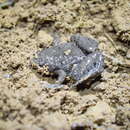Description
provided by AmphibiaWeb articles
M 19.2-22.1 mm, F 22.1-25.6 mm. A small microhylid with a distinctive narrow head and small eyes. Back rather uniform greyish or brownish with a few black spots. Belly dirty white with distinct grey patches and vermiculations. Tympanum indistinct. Lateral metatarsalia connected. Inner metatarsal tubercle small, no outer metatarsal tubercle. Hand without webbing, foot completely webbed. Relative finger length 1
- Glaw, F., and Vences, M. (2007). Field Guide to the Amphibians and Reptiles of Madagascar. Third Edition. Vences and Glaw Verlag, Köln.
- Nussbaum, R. and Vences, M. (2008). Mantidactylus lugubris. In: IUCN 2008. 2008 IUCN Red List of Threatened Species. www.iucnredlist.org. Downloaded on 08 April 2009.
- author
- Miguel Vences
- author
- Frank Glaw
Distribution and Habitat
provided by AmphibiaWeb articles
Located at Ambana, Ambatovaky, Andasibe, Ankeniheny, Ranomafana village, Ranomena (Ranomafana) (Glaw and Vences 2007) from near sea level up to 950 m asl (Cadle and Vences 2008).
- author
- Miguel Vences
- author
- Frank Glaw
Life History, Abundance, Activity, and Special Behaviors
provided by AmphibiaWeb articles
Habits: Widely distributed in eastern rainforests but not regularly encountered. Most likely to be found by chance on the forest floor, or during reproduction by locating calling males which call at night from hidden positions on the ground next to stagnant water bodies in rainforest. Sometimes seen swimming at night in these pools, immediately diving when disturbed. Amplexus is axillary. 107-408 black eggs of 1 mm diameter are deposited which characteristically float on the water surface, partly emerging above the surface. Metamorphosing juveniles 8-9 mm SVL (Glaw and Vences 2007). Calls: A cricket-like loud and short melodious trill (Glaw and Vences 2007).
- author
- Miguel Vences
- author
- Frank Glaw
Life History, Abundance, Activity, and Special Behaviors
provided by AmphibiaWeb articles
This species is listed as least concern because, although it is seldom recorded, it has a relatively wide distribution, is tolerant of a degree of habitat modification, has a presumed large population, and because it is unlikely to be declining fast enough to qualify for listing in a more threatened category. Though it occurs in protected areas, its forest habitat is receding due to subsistence agriculture, timber extraction, charcoal manufacture, and invasive spread of eucalyptus, livestock grazing and expanding human settlements (Cadle and Vences 2008).
- author
- Miguel Vences
- author
- Frank Glaw
Paradoxophyla palmata
provided by wikipedia EN
- license
- cc-by-sa-3.0
- copyright
- Wikipedia authors and editors
Paradoxophyla palmata: Brief Summary
provided by wikipedia EN
Paradoxophyla palmata is a species of frog in the family Microhylidae. It is endemic to Madagascar. Its natural habitats are subtropical or tropical moist lowland forests, intermittent freshwater marshes, and heavily degraded former forest. It is threatened by habitat loss.
- license
- cc-by-sa-3.0
- copyright
- Wikipedia authors and editors

